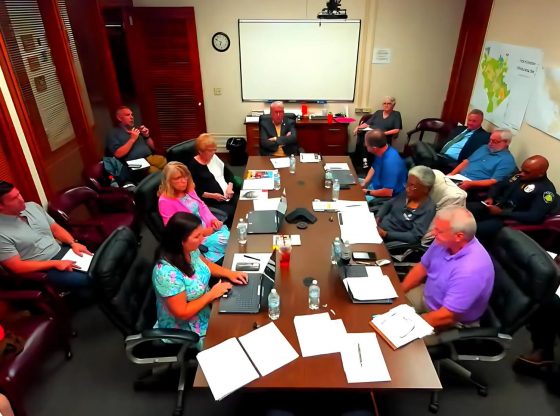The Moore County Opioid Task Force turned its attention Monday to the details of a 16-year plan for settlement funds. Members of the task force zeroed in on early prevention strategies, veterans’ care, and measuring the effectiveness of programs already underway.
Funding and Strategies
County Manager Wayne Vest opened the meeting with a breakdown of the $11.7 million Moore County expects to receive through 2038 as part of the nationwide opioid settlement. Vest said the county has already received more than $4.5 million, with $1.3 million contracted and just under $900,000 reimbursed. So far, about 28% of available funds have been allocated.
“The board previously chose to go with Option A, which offers twelve options that can be used for funding,” explained Vest. “At the last meeting, we really sort of thought about the fact that early intervention is the key. If you can catch them early and prevent them from becoming part of the pipeline, you can save money on housing and resources, and lives, too.”
The twelve strategies within this plan are:
Collaborative strategic planning
Evidence-based addiction treatment
Recovery support services
Recovery housing support
Employment-related services
Recovery housing support
Employment-related services
Early intervention
Naloxone distribution
Post-overdose response team
Syringe Service Program
Criminal justice diversion programs
Addiction treatment for incarcerated persons
Reentry Programs
Vest said Moore County has invested nearly $1 million in recovery support services, $138,000 in recovery housing, and $47,000 in early intervention programs, including work with the Boys and Girls Club that reached hundreds of children between September 2023 and August 2025.
Following Vest’s presentation, Nidhi Sachdeva, director of Strategic Health and Opioid Initiatives, took to the podium to answer questions and provide a closer look at the strategies.
According to Sachdeva, in keeping with the National Settlement Agreement, opioid settlement funds may support programs or services that serve individuals with opioid use disorder or any co-occurring substance use disorder or mental health condition.
Sachdeva stated that while settlement funds represent a noteworthy investment, they fall short of addressing the scope of the crisis.
“It’s a meaningful amount of money, but it’s not enough,” Sachdeva said. “This epidemic is not new to these communities. It’s been ongoing for decades. The settlement may be new, but the issue is not.”
Early Intervention Strategy
Of the representatives present—including Moore County Commissioners Tom Adams and John Ritter—many had questions specifically about the early intervention strategies discussed at previous meetings.
Sachdeva said early intervention is among the most difficult strategies to implement, but also one of the most impactful. Rather than broad prevention campaigns, she urged the task force and representatives of treatment centers to aim for evidence-based, individualized support for children already showing signs of risk, such as behavioral issues, family instability, or parental incarceration.
For example, Sachdeva placed importance on the belief that one-on-one sessions with a guidance counselor do more good for at-risk youths than a presentation given to a whole auditorium of students.
However, Tony Price, who is both vice chairman of the board of directors for the Boys and Girls Club of the Sandhills and also chief executive officer at Moore Free & Charitable Clinic, vocalized concern that singling out at-risk children does more harm than good and causes them to feel ostracized.
“We don’t want to ostracize kids. We don’t want to label them too early,” said Price. “At an early age, all kids are somewhat exposed. Whether this is through a friend or an adult, we often don’t know until it’s too late. If we have to carve them out as you suggest … that’s when they become ostracized, and that’s when they become resistant.”
Ritter agreed. “I think any child today could be considered at-risk,” he said.
“We don’t want kids to feel pushed aside or labeled,” answered Sachdeva, explaining that many of the strategies are based on potential funding options. “The programs are prorated based on data. Say you have a program with 100 kids, and 20 of them have been referred to you through an alert system. You on the back end know those kids were identified, which means 20% of the money going to support that program could come from the settlement.”
Board member Frank Quis spoke favorably of several instances where patients who had successfully recovered visited schools and spoke about the times when they were at their lowest, and how opioids and substance abuse had drastic, negative effects on their lives. He suggested that hearing these testimonies from graduates of Sandhills Adult and Teen Challenge could provide perspective on the detrimental effects of addiction.
“Scaring kids doesn’t work,” Sachdeva said. “They just stop listening. We need to try something different.”
She added that many at-risk kids experience “big feelings in little bodies” and display signs of poor emotional regulation.
Others from the audience said that educating and caring for the parents of at-risk children is important to indirectly support children.
Julia Latham, representing Partners for Children and Families, noted that five children are born each month in Moore County with prenatal drug exposure. She said early home visitation programs and parental support would be beneficial to the children in these instances.
“We want to work with the health department or work with FirstHealth for possible nurse visitation [for these children],” started Latham. “They’d benefit from nurses doing in-home and family visitation for the first couple of years, making sure the mother has the support she needs within the community, putting eyeballs on the children, and making sure they’re hitting their milestones.”
“By supporting the parent, you are supporting the kid,” Sachdeva said. “That’s why eleven of the twelve strategies focus on adults instead of kids. We’re all complicated creatures.”
Veteran Care and Additional Discussion
Vest steered the conversation toward care for veterans, with Sachdeva explaining that settlement funds can support veterans with substance use disorders if opioid misuse is part of their history. She did, however, reference treatment for veterans who have been incarcerated and that “a lot of veterans also have concurring substance abuse issues.”
“Veterans’ treatment is something you all are interested in,” Sachdeva said. “If a veteran abuses multiple substances, such as alcohol, or has mental health conditions, and they also have a known history of opioid use, you can serve them as a whole person just like you could anyone else. If a person only has depression or PTSD, they wouldn’t qualify.”
As the meeting neared its end, Adams and Ritter wanted to know more about programs that have worked in other counties.
However, Sachdeva cautioned against copying programs without considering local needs, stating that North Carolina is exceedingly diverse and local committees need to figure out what works best for their communities instead. “You can’t see what works elsewhere and say you want it here because you lose all of the context,” she said.
Before Vest closed the meeting, several officials, including Ritter and Price, agreed that they would benefit from another work session to determine how to best serve Moore County on a personalized level for the most effective plan possible.
For Moore news delivered straight to your inbox, please click here to sign up for the free Sandhills Sentinel e-newsletter.
~ Written by Sandhills Sentinel Assistant Editor Abegail Murphy. Abegail has been writing for Sandhills Sentinel since 2021.



















